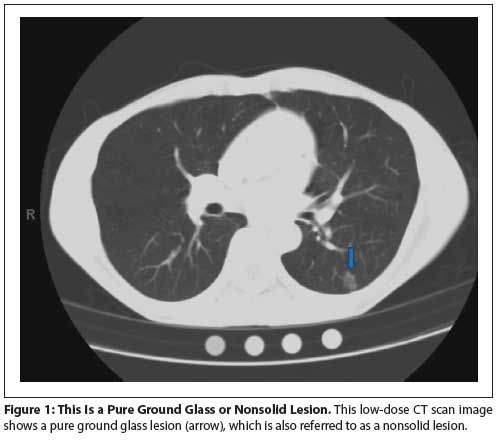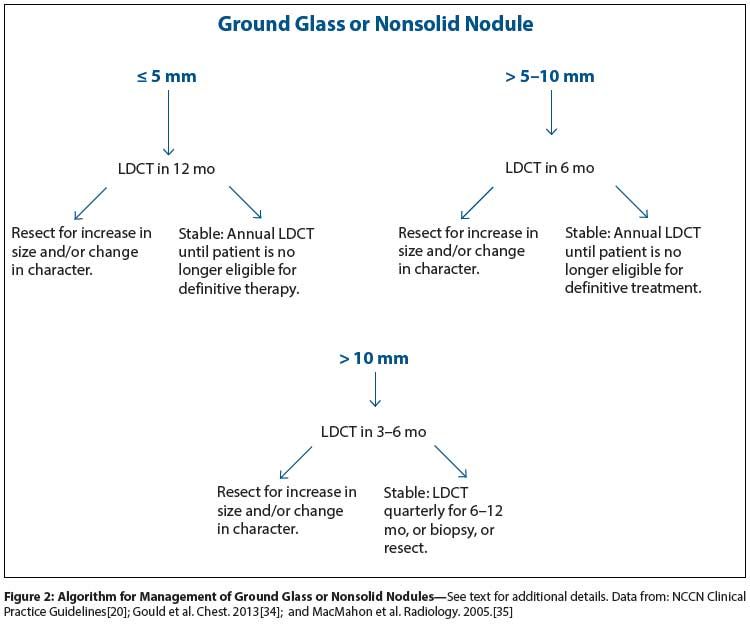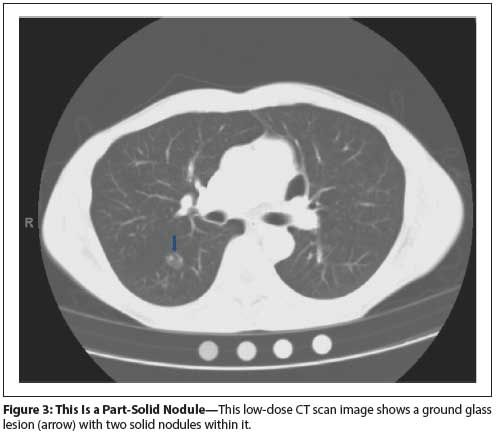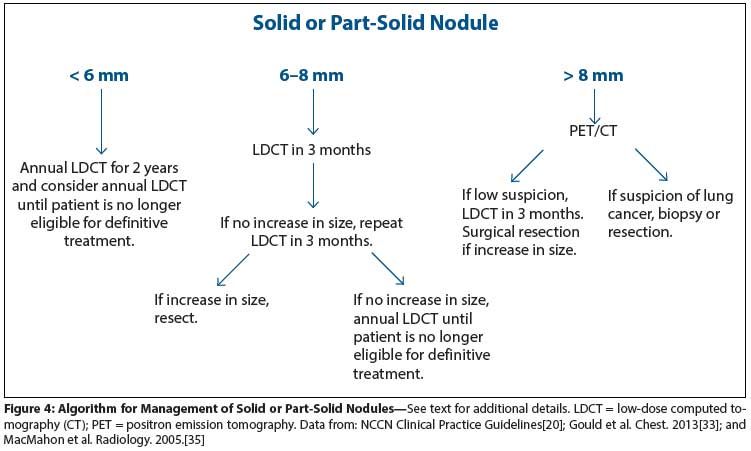Low-Dose Spiral CT Screening and Evaluation of the Solitary Pulmonary Nodule
The number of lesions detected with low-dose CT, only some of which are early cancers, is so great that algorithms are being developed for more efficient evaluation and management of solitary pulmonary nodules. This article will discuss current tools, approaches, and concerns regarding patient care in this setting.
Figure 1: This Is a Pure Ground Glass or Nonsolid Lesion.

Figure 2: Algorithm for Management of Ground Glass or Nonsolid Nodules

Figure 3: This Is a Part-Solid Nodule

Figure 4: Algorithm for Management of Solid or Part-Solid Nodules

Lung cancer screening using helical low-dose computerized tomography (LDCT) increased drastically after publication of a successful well-designed prospective randomized screening study, the National Lung Screening Trial. This increase in screening has led to a significant increase in the diagnosis of solitary pulmonary nodules (SPNs). Some of these lesions are early cancers, and their removal can potentially prevent a lung cancer death. Some have the histologic appearance of a cancer but will never progress and cause harm. Some are non-neoplastic and are best observed. The number of lesions detected with LDCT is so great that algorithms are being developed for more efficient evaluation and management of SPNs. This article will discuss current tools, approaches, and concerns regarding patient care in this setting.
Lung cancer is the leading cause of cancer death in the Western world. Efforts to control lung cancer include prevention through tobacco control as well as cancer screening. Lung cancer screening using radiologic imaging has been of interest for more than half a century. Chest x-rays increased 5-year survival rates and was advocated until several clinical trials failed to demonstrate that they led to reduced risk of death.[1] Indeed, radiologists were stunned when a meta-analysis of chest x-ray screening studies suggested that screening actually might have a net harmful effect.[2]
Improvements in technology have fueled interest in CT as a screening tool. Further improvements led to the development of fast low-dose spiral CT that could image the lungs as patients hold their breath for 20 seconds or less. LDCT also exposed the patient to less radiation, an average of 1.5 mSv vs 8 mSv for conventional CT. Newer scanners may subject the patient to even less radiation. Several single-arm studies have been conducted over the past 2 decades and demonstrated that LDCT can find lung cancers.[3] These studies also demonstrated that LDCT can detect benign lesions.
As the spatial resolution of CT scanners has increased, ever-smaller abnormal lesions have been detected. While more lesions clearly were being found, the legitimate question arose of whether CT scanning technology was preventing lung cancer deaths. Many of the lesions discovered were not cancerous, and evaluation to determine the nature of a lesion can involve invasive procedures. Complications of transthoracic biopsy, bronchoscopy, and thoracotomy can be significant.
The National Lung Screening Trial (NLST) was launched in 2002.[4,5] It is a well-designed prospective randomized clinical trial that showed that LDCT combined with good evaluation and treatment decreases relative risk of lung cancer death. This landmark study was conducted at 33 clinical sites by investigators with expertise in lung cancer imaging, diagnosis, and treatment.
The NLST involved 53,452 persons at high risk for lung cancer. Subjects were current or former smokers aged 55 to 74 with at least a 30 pack-year history of smoking. Former smokers were eligible if they had quit smoking within the previous 15 years. These subjects were prospectively randomized to screening with LDCT or a one-view chest x-ray. Screening was performed annually three times. LDCT scans that revealed any noncalcified nodule measuring at least 4 mm in diameter were classified as positive or “suspicious for” lung cancer. As there was no validated approach to the evaluation of a nodule at the time, no specific evaluation approach was mandated.
With a median follow-up of 6.5 years, there were 13% more lung cancers and a 20% reduction in lung cancer mortality (95% confidence interval [CI], 6.8–26.7; P = .004) in the LDCT arm compared with the chest x-ray arm. The ability of CT imaging to find suspicious lesions was well demonstrated by the trial. The risk of a false-positive finding in the first screen was 21%. Overall, after three CTs, 39.1% of participants had at least one positive screening result. Of those who screened positive, the false-positive rate was 96.4% in the LDCT group.[5]
Suspicious lesions and the associated diagnostic procedures are associated with anxiety, expense, and risk of complications (eg, pneumothorax or hemothorax after lung biopsy).[6] In the NLST study arm, there were 16 deaths within 60 days of an invasive diagnostic procedure. Six of the 16 ultimately did not have cancer. While it is not known whether these deaths were directly caused by the invasive procedure, such findings do give pause and warrant study of how to efficiently evaluate abnormal lesions.[7]
Solitary Pulmonary Nodules: Differential Diagnosis
The most common abnormal finding on LDCT is a solitary pulmonary nodule (SPN).[8,9] In some studies, about half of all smokers aged 50 or older have them. Biopsy of every lesion is not feasible. Even CT follow-up of all detected noncalcified nodules would require a large number of studies at considerable expense. There would also be substantial radiation exposure.
The single-armed screening studies actually indicate that about 1% of SPNs are malignant. Most malignant SPNs are primary lung cancers. Metastatic spread from other cancers and carcinoid tumors are also found. Of primary lung tumors, the bulk are adenocarcinomas, but large-cell and squamous-cell tumors can present as solitary nodules. Metastases that present as SPNs can come from almost any non-lung primary, but most common are melanoma, sarcoma, and cancers of the colon and breast.
Benign lesions are most commonly infectious in etiology, especially histoplasmosis, coccidioidomycosis, blastomycosis, cryptococcosis, and mycobacteria.[10] Abscesses caused by Staphylococcus aureus, Pneumocystis jirovecii, echinococcus, or aspergilloma can also present as an SPN.[11] Noninfectious causes include pulmonary arteriovenous malformations, hamartomas, fibromas, and leiomyomas. Rarely, inflammatory lesions caused by Wegener granulomatosis, rheumatoid arthritis, or sarcoidosis can present as SPNs. Occasionally, an intrapulmonary lymph node will appear on CT as an SPN.
Important in the evaluation of SPNs are clinical and radiologic features that suggest the likelihood of the lesion being malignant. Clinical features to be considered include age, a history of smoking, family history of lung cancer, emphysema, and asbestos exposure. Approximately 85% of all SPNs found to be cancerous are diagnosed in persons 50 years of age and older.[12] The NLST was a very high–risk cohort. A quarter of all deaths during trial follow-up were due to lung cancer. Risk factors used for entry criteria were 55–74 years old, at least a 30 pack-year smoking history, and currently smoking or having quit within the past 15 years. There is evidence of better outcomes when more risk factors are used to tailor screening for a high-risk population.[13,14]
Imaging of Nodules
Helical or spiral CT is commonly used in lung screening. Today’s technology allows imaging with radiation doses of 0.5 to 1.0 mSv, and the examination can often be completed in as little as 3 seconds. This eliminates most artifacts that are due to respiratory motion. Axial sections are commonly reconstructed at 0.5 to 2 mm in thickness.
A positron emission tomography (PET) scan is often used to demonstrate the metabolic activity of a nodule. It is important to remember the limitations of PET.[15] While the functional imaging of PET is widely used to evaluate SPNs, it should be remembered that a standardized uptake value (SUV) of
< 2.5 can indicate malignancy. Infectious and inflammatory conditions can cause false-positive results, and some malignancies will be falsely negative. Small malignant lesions especially can be falsely negative, due to a lack of critical mass. Larger malignant tumors that can be falsely negative on PET are minimally invasive adenocarcinomas, mucinous adenocarcinomas, adenocarcinomas in situ, and carcinoid tumors.[16-18]
Radiologic Features of Solitary Pulmonary Nodules
An SPN is a single well-circumscribed radiographic lesion < 30 mm in size. It can be completely surrounded by normal aerated lung tissue or can abut pleura or another thoracic structure. A nodule can be ground glass or nonsolid, solid, or part-solid (ground glass with a solid component). Solid nodules can be calcified or noncalcified.
Radiologic features that portend the probability of malignancy include size, attenuation, growth rate, border, calcification, and location.
Size is measured as the maximum diameter on CT scan. Larger nodules are more likely than smaller nodules to be malignant. While less than 1% of SPNs < 5 mm in size are malignant, 18% to 20% of lesions 8 mm to 20 mm are malignant, and more than half of all lesions greater than 20 mm are cancerous. Lesions 8 mm to 30 mm in size present the most difficulty with regard to determining appropriate management. Masses > 30 mm are technically not nodules. They have a > 80% likelihood of malignancy.[19]
Attenuation refers to a lesion’s classification as solid, part-solid, or ground glass. Solid lesions of 8 mm or smaller are rarely cancerous. They are also hard to biopsy and are not easily assessed on PET scan. It is common to follow them over time with CT scans. Solid lesions larger than 8 mm are more likely malignant. They are easier to assess with PET and easier to biopsy.[20]
Nonsolid or ground glass nodules (see Figures 1 and 2) are not very dense. Lung structures such as airways and blood vessels can be seen through them on CT scans.[8,21,22] Small ground glass lesions are difficult to biopsy and are not amenable to functional imaging. Ground glass lesions ≤ 10 mm are rarely cancerous. Ground glass lesions that persist over time are more likely to be malignant. Mixed lesions that have a solid component are more likely to be cancerous (see Figures 3 and 4).
Growth rate can be assessed using serial CT scans. High-resolution CT can assess a 0.5-mm change in size.[23] Volume doubling time is a metric used to assess growth rate. The Nederlands Leuvens Longkanker Screenings Onderzoek Trial (NELSON) has used measurement of tumor doubling to lower the false-positive rate of LDCT. The false-positive rate in NELSON was 64%, compared with 96% in the NLST.[24,25] Solid lesions that are aggressive malignancies usually have volume doubling times of
20–400 days. Low-grade cancers and pre-invasive malignancies generally have doubling times > 400 days. A growing lesion should be biopsied. Conversely, a solid nodule that is stable for 2 years and a ground glass lesion that is stable for 3 years are generally noncancerous and can be watched.
Border. A nodule with a smooth border is less likely to be malignant, whereas one with a scalloped or spiculated border is more likely to be cancer. More than 90% percent of lesions with a corona radiata are malignant.[26,27]
Calcification. A nodule that is fully or diffusely calcified is rarely malignant. Other indicators that suggest a benign lesion include central or concentric calcification and the appearance of a “popcorn” lesion. A nodule that has asymmetric calcification may be a cancer arising from lung tissue scarred by a previous infection, such as tuberculosis.
Location. Malignant lesions can occur anywhere in the lung, but primary lung cancers are more often located in the upper lobes.[22,28]
Quantitative Predictive Models
There are several quantitative predictive models that use clinical and radiologic features to estimate the risk that a nodule is malignant. These models generally focus on SPNs 8–30 mm in size in a population at risk for lung cancer due to smoking exposure history, occupational exposures, and history of chronic obstructive pulmonary disease.[22,28-31] These models categorize nodules as having a low, intermediate, or high probability of malignancy. Intermediate probability is considered a 5% to 65% risk of cancer.
Management of Nodules
Results of the NLST and other screening trials, including NELSON[32,33] and the International Early Lung Cancer Action Program (I-ELCAP),[3] have been invaluable in establishing criteria for post-screening follow-up.
Several respected organizations publish algorithms for the management and evaluation of SPNs found in patients who have been screened because they are at high risk for lung cancer. These include the American College of Chest Physicians,[34] the National Comprehensive Cancer Network,[20] and the Fleischner Society.[35] The Fleischner Society is an international, multidisciplinary group of 100 experts specializing in thoracic radiology that publishes position papers and consensus statements focusing on a number of controversial topics in chest medicine. The recommendations of these organizations are very similar.
Below we present reasonable algorithms or pathways for the evaluation of nodules seen while screening patients at high risk for lung cancer.
Any nodule associated with atelectasis, adenopathy, or a pleural effusion, or any mass greater than 30 mm in size should be evaluated with the assumption that it is likely malignant.[36]
Ground glass or nonsolid nodules
Figure 1 illustrates the appearance of ground glass or nonsolid nodules. These lesions often resolve. The algorithm in Figure 2 highlights appropriate management.[20,34,35] Lesions
≤ 5 mm warrant LDCT every 12 months. They should be resected for an increase in size or a change in character. Ground glass or nonsolid nodules between 5 mm and 10 mm in size should undergo a repeat LDCT in 6 months. An increase in size or change in character warrants resection. Stable lesions should be followed with annual LDCT. Ground glass or nonsolid lesions > 10 mm should be reassessed with LDCT in 3 to 6 months. Those that are increasing in size or changing in character should be resected. Those that are stable should be evaluated with LDCT every 6 to 12 months or biopsied or resected.
Solid or part-solid nodules
The algorithm in Figure 4 outlines management in this setting.[20,34,35] A single solid or part solid pulmonary nodule < 6 mm in a person at high risk should be watched with annual low-dose CT. A solid or part-solid nodule 6 to 8 mm in size merits a repeat LDCT scan in 3 months and, if stable, again 3 months later. If it is growing, then it should be resected. If it is stable, then the patient should undergo LDCT screening annually. A nodule greater than 8 mm in size warrants evaluation with a PET/CT scan. Nodules that are of low suspicion after PET warrant repeat LDCT in 3 months and resection if there is growth. Those that have a PET result suspicious for cancer should be biopsied or resected.
Biologic Behavior of Malignant Lesions
Most SPNs are not malignant. The 1% or so that are cancerous are most commonly adenocarcinomas, and the incidence of adenocarcinoma is increasing. Even for cancerous tumors, greater attention is being devoted to biologic behavior and to the prediction of aggressiveness.
Overdiagnosis is the finding of a cancer that is indolent and does not need treatment. It can be a tumor that fulfills the histologic requirements of malignancy, but that, if left alone, will never grow, metastasize, and cause harm; or it can be a malignant tumor that will never progress to clinical significance within the host patient’s lifetime. An overdiagnosis cancer is by definition asymptomatic. In prior years, these tumors would never have been diagnosed.
The results of prospective randomized clinical studies such as the NLST indicate that while we cure some patients who do not need to be cured, we also cure some patients who need to be cured. An estimate of the prevalence of overdiagnosis can be made by comparing the rate of localized cancers over time with the death rate. This was done with the NLST. Of lung cancers diagnosed in this trial, it is estimated that 18.5% (95% CI, 5.4%–30.6%) were cases of overdiagnosis.[37] A total of 22.5% (95% CI, 9.7%–34.3%) of non–small-cell lung cancers detected and 78.9% (95% CI, 62.2%–93.5%) of bronchioloalveolar lung cancers (also known as in situ pulmonary adenocarcinoma) detected by LDCT represented overdiagnosis. The investigators estimating overdiagnosis in the NLST noted that the estimate of overdiagnosis may go down with longer follow-up.[1,38] The US Preventive Services Task Force commissioned some modeling that estimated overdiagnosis at < 17% and likely about 10%.[39] One analysis of the US Prostate, Lung, Colorectal, and Ovarian (PLCO) trial suggested that overdiagnosis might be as low as 6% of screened diagnosed cancers.[40] It is fair to say that the exact proportion of lung tumors that are overdiagnosis cancers is unknown, but the concept of overdiagnosis in lung cancer is real.
Overdiagnosis is becoming a greater issue with the dramatic improvements in radiologic imaging and stereotactic biopsy technology. Our definitions of cancer are based on histologic study of tumors taken at autopsy in the mid 19th century. We need a 21st century definition of cancer that involves genomics in addition to histology. At this time it is not possible to identify a specific patient’s cancer as an overdiagnosis tumor. Genomic research holds promise for predicting the biologic behavior of a tumor once it is biopsied. We have yet to develop non-invasive predictors.
Financial Disclosure:The authors have no significant financial interest in or other relationship with the manufacturer of any product or provider of any service mentioned in this article.
References:
1. Marcus PM, Bergstralh EJ, Zweig MH, et al. Extended lung cancer incidence follow-up in the Mayo Lung Project and overdiagnosis. J Natl Cancer Inst. 2006;98:748-56.
2. Manser RL, Irving LB, Byrnes G, et al. Screening for lung cancer: a systematic review and meta-analysis of controlled trials. Thorax. 2003;58:784-9.
3. Henschke CI, Yip R, Yankelevitz DF, Smith JP. Computed tomography screening for lung cancer. Ann Intern Med. 2013;159:156-7.
4. Aberle DR, Berg CD, Black WC, et al. The National Lung Screening Trial: overview and study design. Radiology 2011;258:243-53.
5. Aberle DR, Adams AM, Berg CD, et al. Reduced lung-cancer mortality with low-dose computed tomographic screening. N Engl J Med. 2011;365:395-409.
6. Van’t Westeinde SC, Horeweg N, De Leyn P, et al. Complications following lung surgery in the Dutch-Belgian randomized lung cancer screening trial. Eur J Cardiothorac Surg. 2012;42:420-9.
7. Bach PB, Mirkin JN, Oliver TK, et al. Benefits and harms of CT screening for lung cancer: a systematic review. JAMA. 2012;307:2418-29.
8. Henschke CI, Yankelevitz DF, Mirtcheva R, et al. CT screening for lung cancer: frequency and significance of part-solid and nonsolid nodules. AJR Am J Roentgenol. 2002;178:1053-7.
9. Ost D, Fein AM, Feinsilver SH. Clinical practice. The solitary pulmonary nodule. N Engl J Med. 2003;348:2535-42.
10. Gribetz AR, Damsker B, Bottone EJ, et al. Solitary pulmonary nodules due to nontuberculous mycobacterial infection. Am J Med. 1981;70:39-43.
11. Barrio JL, Suarez M, Rodriguez JL, et al. Pneumocystis carinii pneumonia presenting as cavitating and noncavitating solitary pulmonary nodules in patients with the acquired immunodeficiency syndrome. Am Rev Respir Dis. 1986;134:1094-6.
12. Toomes H, Delphendahl A, Manke HG, Vogt-Moykopf I. The coin lesion of the lung. A review of 955 resected coin lesions. Cancer. 1983;51:534-7.
13. Kovalchik SA, Tammemagi M, Berg CD, et al. Targeting of low-dose CT screening according to the risk of lung-cancer death. N Engl J Med. 2013;369:245-54.
14. Tammemagi MC, Katki HA, Hocking WG, et al. Selection criteria for lung-cancer screening. N Engl J Med. 2013;368:728-36.
15. Chang CF, Rashtian A, Gould MK. The use and misuse of positron emission tomography in lung cancer evaluation. Clin Chest Med. 2011;32:749-62.
16. Fletcher JW, Kymes SM, Gould M, et al. A comparison of the diagnostic accuracy of 18F-FDG PET and CT in the characterization of solitary pulmonary nodules. J Nucl Med. 2008;49:179-85.
17. Ashraf H, Dirksen A, Loft A, et al. Combined use of positron emission tomography and volume doubling time in lung cancer screening with low-dose CT scanning. Thorax. 2011;66:315-9.
18. Ohno Y, Koyama H, Matsumoto K, et al. Differentiation of malignant and benign pulmonary nodules with quantitative first-pass 320-detector row perfusion CT versus FDG PET/CT. Radiology. 2011;258:599-609.
19. Ost D, Fein A. Evaluation and management of the solitary pulmonary nodule. Am J Respir Crit Care Med. 2000;162:782-7.
20. NCCN Clinical Practice Guidelines in Oncology: lung cancer screening. Version 2.2014. Available from: http://www.nccn.org/. Accessed April 4, 2014.
21. Li F, Sone S, Abe H, et al. Malignant versus benign nodules at CT screening for lung cancer: comparison of thin-section CT findings. Radiology. 2004;233:793-8.
22. McWilliams A, Tammemagi MC, Mayo JR, et al. Probability of cancer in pulmonary nodules detected on first screening CT. N Engl J Med. 2013;369:910-19.
23. Honda O, Johkoh T, Sumikawa H, et al. Pulmonary nodules: 3D volumetric measurement with multidetector CT-effect of intravenous contrast medium. Radiology. 2007;245:881-7.
24. Field JK, Smith RA, Aberle DR, et al. International Association for the Study of Lung Cancer Computed Tomography Screening Workshop 2011 report. J Thorac Oncol. 2012;7:10-19.
25. Ru Zhao Y, Xie X, de Koning HJ, et al. NELSON lung cancer screening study. Cancer Imaging. 2011;11(Spec No A):S79-84.
26. Rigler LG. An overview of cancer of the lung. Semin Roentgenol. 1977;12:161-4.
27. Zerhouni EA, Stitik FP, Siegelman SS, et al. CT of the pulmonary nodule: a cooperative study. Radiology. 1986;160:319-27.
28. Swensen SJ, Silverstein MD, Ilstrup DM, et al. The probability of malignancy in solitary pulmonary nodules. Application to small radiologically indeterminate nodules. Arch Intern Med. 1997;157:849-55.
29. Gould MK, Ananth L, Barnett PG. A clinical model to estimate the pretest probability of lung cancer in patients with solitary pulmonary nodules. Chest. 2007;131:383-8.
30. Mehta HJ, Ravenel JG, Shaftman SR, et al. The utility of nodule volume in the context of malignancy prediction for small pulmonary nodules. Chest. 2014;145:464-72.
31. Cummings SR, Lillington GA, Richard RJ. Estimating the probability of malignancy in solitary pulmonary nodules. A Bayesian approach. Am Rev Respir Dis. 1986;134:449-52.
32. Horeweg N, van der Aalst CM, Thunnissen E, et al. Characteristics of lung cancers detected by computer tomography screening in the randomized NELSON trial. Am J Respir Crit Care Med. 2013;187:848-54.
33. Horeweg N, van der Aalst CM, Vliegenthart R, et al. Volumetric computed tomography screening for lung cancer: three rounds of the NELSON trial. Eur Respir J. 2013;42:1659-67.
34. Gould MK, Donington J, Lynch WR, et al. Evaluation of individuals with pulmonary nodules: When is it lung cancer? Diagnosis and management of lung cancer, 3rd ed. American College of Chest Physicians evidence-based clinical practice guidelines. Chest. 2013;143:e93S-120S.
35. MacMahon H, Austin JH, Gamsu G, et al. Guidelines for management of small pulmonary nodules detected on CT scans: a statement from the Fleischner Society. Radiology. 2005;237:395-400.
36. Steele JD. The solitary pulmonary nodule. Report of a cooperative study of resected asymptomatic solitary pulmonary nodules in males. J Thorac Cardiovasc Surg. 1963;46:21-39.
37. Patz EF, Jr, Pinsky P, Gatsonis C, et al. Overdiagnosis in low-dose computed tomography screening for lung cancer. JAMA Intern Med. 2014;174:269-74.
38. Veronesi G, Maisonneuve P, Bellomi M, et al. Estimating overdiagnosis in low-dose computed tomography screening for lung cancer: a cohort study. Ann Intern Med. 2012;157:776-84.
39. de Koning HJ, Meza R, Plevritis SK, et al. Benefits and harms of computed tomography lung cancer screening strategies: a comparative modeling study for the U.S. Preventive Services Task Force. Ann Intern Med. 2014;160.
40. Oken MM, Hocking WG, Kvale PA, et al. Screening by chest radiograph and lung cancer mortality: the Prostate, Lung, Colorectal, and Ovarian (PLCO) randomized trial. JAMA. 2011;306:1865-73.